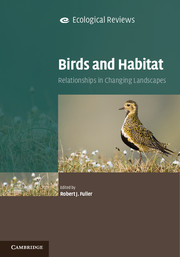Book contents
- Frontmatter
- Contents
- List of Contributors
- Preface
- Part I The complexity of patterns and processes
- Chapter One The bird and its habitat: an overview of concepts
- Chapter Two Habitat quality and habitat occupancy by birds in variable environments
- Chapter Three Spatial variation and temporal shifts in habitat use by birds at the European scale
- Chapter Four Mechanisms and processes underlying landscape structure effects on bird populations
- Chapter Five Avian responses to transitional habitats in temperate cultural landscapes: woodland edges and young-growth
- Chapter Six Habitat associations of birds in complex changing cultural landscapes
- Chapter Seven The importance of habitat heterogeneity at multiple scales for birds in European agricultural landscapes
- Part II Case studies of habitat use and selection
- Part III Wider perspectives
- Species index
- Subject index
- References
Chapter Four - Mechanisms and processes underlying landscape structure effects on bird populations
Published online by Cambridge University Press: 05 December 2012
- Frontmatter
- Contents
- List of Contributors
- Preface
- Part I The complexity of patterns and processes
- Chapter One The bird and its habitat: an overview of concepts
- Chapter Two Habitat quality and habitat occupancy by birds in variable environments
- Chapter Three Spatial variation and temporal shifts in habitat use by birds at the European scale
- Chapter Four Mechanisms and processes underlying landscape structure effects on bird populations
- Chapter Five Avian responses to transitional habitats in temperate cultural landscapes: woodland edges and young-growth
- Chapter Six Habitat associations of birds in complex changing cultural landscapes
- Chapter Seven The importance of habitat heterogeneity at multiple scales for birds in European agricultural landscapes
- Part II Case studies of habitat use and selection
- Part III Wider perspectives
- Species index
- Subject index
- References
Summary
Many studies have related assemblage richness, or the incidence and abundance of individual bird species, to landscape structure. But without understanding the ecological mechanisms and processes underlying observed effects, this remains a description of pattern. Where such patterns are inconsistent among species, landscapes or regions, conceptual advance is limited. Despite this, few studies have tested hypotheses underlying these effects (Thompson et al., 2000). This chapter summarises patterns of avian response to landscape structure and critically examines the evidence for different mechanisms that have been proposed to cause such effects. I focus on avian studies from semi-arid, temperate and boreal regions.
Much landscape-scale research has been driven by urgent concerns over the recent fragmentation of contiguous or extensive natural ecosystems (Andrén, 1994; Thompson et al., 2000; Schmiegelow and Mönkkönen, 2002; Fahrig, 2003). However, faunal composition and responses to patch size, isolation, edges and context may differ between recently fragmented landscapes and ancient mosaics created by millennia of human land use (see also Chapters 3 and 19). Where possible, therefore, I try to contrast evidence from temperate and boreal regions of North and South America, Finland and Scandinavia, with research from southern and western Europe.
- Type
- Chapter
- Information
- Birds and HabitatRelationships in Changing Landscapes, pp. 93 - 124Publisher: Cambridge University PressPrint publication year: 2012
References
- 16
- Cited by

